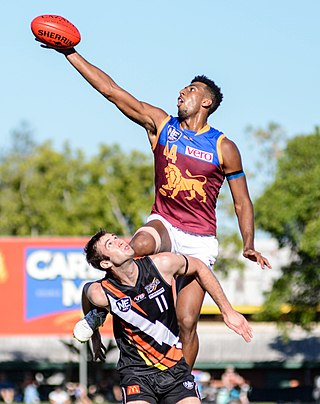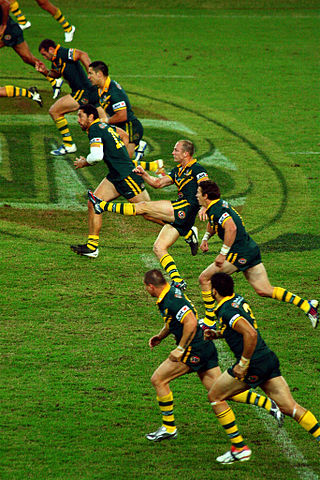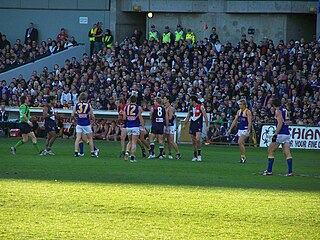
Australian rules football, also called Australian football or Aussie rules, or more simply football or footy, is a contact sport played between two teams of 18 players on an oval field, often a modified cricket ground. Points are scored by kicking the oval ball between the central goal posts, or between a central and outer post.

The West Australian Football League is an Australian rules football league based in Perth, Western Australia. The league currently consists of ten teams, which play each other in a 20-round season usually lasting from April to September, with the top five teams playing off in a finals series, culminating in a Grand Final. The league also runs reserves, colts (under-19) and women's competitions.

Football in Australia refers to numerous codes which each have major shares of the mainstream sports market, media, broadcasting, professional athletes, financial performance and grassroots participation: Australian rules football, rugby league, rugby union and soccer. There are four pre-eminent professional football competitions played in Australia: the Australian Football League, the National Rugby League, Super Rugby and the A-League (soccer). By most measures, including attendance, television audience and media presence across the most states, Australian football is the most popular nationally. However, in the states of New South Wales and Queensland, rugby football is overall the most watched and receives the most media coverage, especially the Rugby League State of Origin contested between the two states referred to as “Australian sport's greatest rivalry”. In recent times, there has been an increase in popularity in Australian football and corresponding decrease in popularity of Rugby union in New South Wales and Queensland. Soccer, while extending its lead in participation rate, particularly in the large cities, and improving its performance at the FIFA World Cup and at the FIFA Women's World Cup, continues to attract the overall lowest attendance, as well as media and public interest, of the four codes.

The State of Origin series is an annual best-of-three rugby league series between two Australian state representative sides, the New South Wales Blues and the Queensland Maroons.

Rugby league in Australia has been one of Australia's most popular sports since it started being played there in 1908. It is the dominant winter football code in the states of New South Wales and Queensland. In 2022, it was the most watched sport on Australian television with an aggregate audience of 137.3 million viewers. The premier club competition is the National Rugby League (NRL), which features ten teams from New South Wales, four teams from Queensland, and one team each from Victoria, the Australian Capital Territory and New Zealand. The premier representative competition is the annual Rugby league State of Origin featuring two sides, the New South Wales Blues and the Queensland Maroons is often referred to as "Australian sport's greatest rivalry", it is one of Australia's premier sporting events, attracting huge interest and television audiences.

Representative matches in Australian rules football are matches between representative teams played under the Australian rules, most notably of the colonies and later Australian states and territories that have been held since 1879. For most of the 20th century, the absence of a national club competition in Australia and international matches meant that intercolonial and later interstate matches were regarded with great importance.

Australian rules football in Queensland was the first official football code played in 1866. The Colony of Queensland was the second after Victoria to adopt Australian rules football, just days after the rules were widely published. For two decades it was the most popular football code, however a strong desire for representative football success saw Queenslanders favour British football variants for more than a century. As a result, Queensland is one of the two states to the east of the Australian cultural divide described as the Barassi Line. 120 years later in 1986 Queensland was the first state awarded a licence to have a club, the Brisbane Bears, in the national (AFL) competition, also its first privately owned club. However the Gold Coast based Bears had a detrimental effect until the 1993 redevelopment of the Brisbane Cricket Ground (Gabba). In contrast the Bears transformation into a Brisbane and traditional membership based club resulted in enormous growth, and a tripling of average AFL attendances by 1996.

Australian rules football in England is a team sport and spectator sport with a long history. It is home to the longest running Australian rules fixture outside Australia, the match between Oxford and Cambridge Universities which has been contested annually since 1923. The current competitions originated in 1989 and have grown to a number of local and regional leagues coordinated by AFL England. In 2018, these regional divisions were the AFL London, AFL Central & Northern England and Southern England AFL.

Australian rules football in New South Wales is a team sport played and observed in the Australian state. It dates back to the colonial era in 1866, with organised competitions being continuous since the 1880s. Today, it is popular in several regions of the state, including areas near the Victorian and South Australian borders—Riverina, Broken Hill, and South Coast. These areas form part of an Australian cultural divide described as the Barassi Line. To the east of the line, it is known as "AFL", named after the elite Australian Football League competition. AFL NSW/ACT is the main development body, and includes the Australian Capital Territory.

The Queensland rugby league team represents the Australian state of Queensland in rugby league football. Nicknamed the "Maroons" after the colour of their jersey, they play three times a year against arch-rivals New South Wales in the State of Origin series. The team is currently coached by Billy Slater and captained by Daly Cherry-Evans, and is administered by the Queensland Rugby League. They play all of their home matches at Brisbane's Lang Park.

Australian rules football in Western Australia (WA) is the most popular sport in the state. It is governed by the West Australian Football Commission (WAFC).

Australian rules football in Victoria is the most watched and second most participated code of football. Australian rules football originated in Melbourne in the late 1850s and grew quickly to dominate the sport, which it continues to. Victoria has more than double the number of players of any other state in Australia accounting for approximately 42% of all Australian players in 2023 and continues to grow strongly. Only Soccer in Victoria has more football participants, though the code's growth in Victoria has made up much ground lost to that code over previous decades such that they have now a similar number of players. The sport is governed by AFL Victoria based in Melbourne. The national governing body, the AFL Commission is also based in Melbourne.

Australian rules football is the most watched and attended sport and the second most participated code of football in Australia. Since originating in Victoria in 1858 and spreading elsewhere from 1866, it has been played continuously in every Australian state since 1903 plus the two major territories since 1916.
Michael Clifford Fitzpatrick is an Australian businessman, sporting administrator and former professional Australian rules football player. He was chairman of the AFL Commission from 2007 to 2017.

The Australian National Football Council (ANFC) was the national governing body for Australian rules football in Australia from 1906 until 1995. The council was a body of delegates representing each of the principal leagues which controlled the sport in their respective regions. The council was the owner of the laws of the game and managed interstate administrative and football matters. Its function was superseded by the AFL Commission.

The Victoria Australian rules football team, known colloquially as the Big V, is the state representative side of Victoria, Australia, in the sport of Australian rules football.

Rugby union in Victoria describes the sport of rugby union being played and watched in the state of Victoria in Australia. The code was first introduced some time between the 1850s and 1880s but remained a minor sport played primarily in the private schools and amongst interstate expats. This has changed, particularly since the professionalisation of the game in the mid 1990s.

The history of sport in Australia dates back to the pre-colonial period of the country.

On Monday, 13 June 1960, the Tasmanian state team hosted a Victorian state team in an interstate Australian rules football match at York Park, Launceston. The Tasmanian team won by seven points, considered one of the biggest interstate football upset victories of all time, and one of the greatest moments in the history of Tasmanian football. It was the first of only two victories by Tasmania against a Victorian Football League or Victorian state of origin team, from a total of 29 matches. A then-record Launceston crowd of 15,600 attended the game.
The Interstate Rugby League Series refers to Australian Rugby league matches played between the New South Wales rugby league team, colloquially known as the 'Blues', and the Queensland rugby league team, known as the 'Maroons', between 1908 and 1981. The Interstate Series concept was based upon the state of residency of the player, however, due to NSW dominance from 1962 to 1981 winning 20 straight Interstate titles, the State of Origin concept was initiated in 1980, and after two exhibition matches, succeeded the Interstate Series in 1982.

















